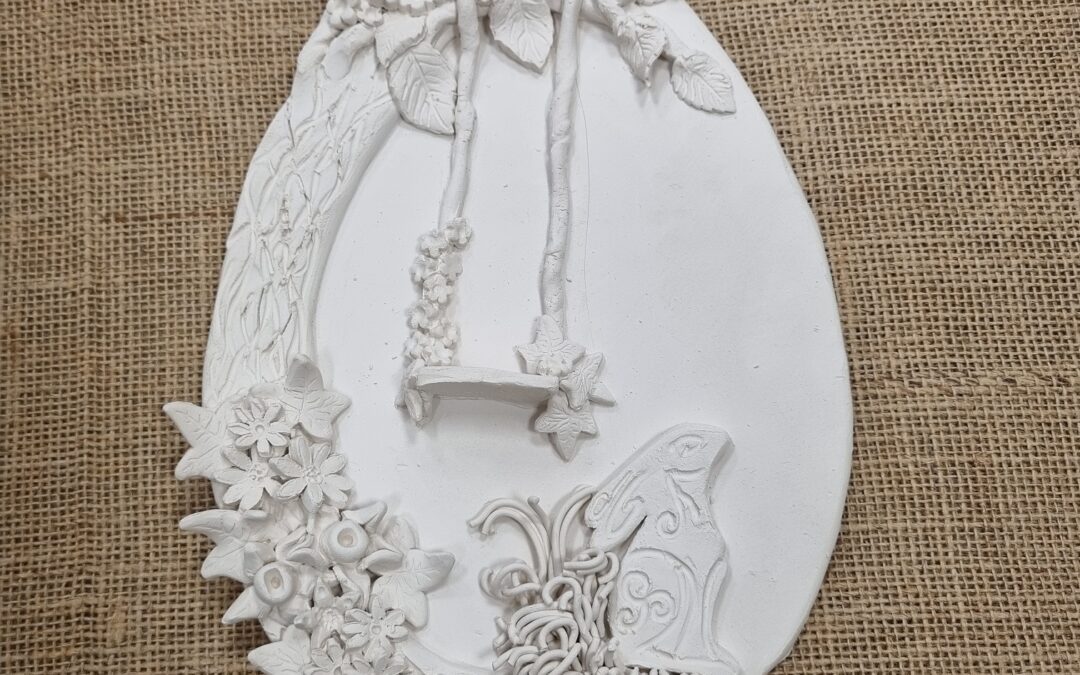History of why Easter is called Easter, inspiring me to create the Spring festival plaque for the clay workshop at Fired 4 U
Back in pagan Anglo-Saxon times, mid-7th century, they held a Spring time festival in honour of Eostre, or in Northumbrian Eastro, worshipping the Goddess of Spring called by these names. Thanking her for better weather, fertility of plants and life in general. She is believed to be the name sake for the Christian holiday of Easter. Ancient pictures of her include hares and eggs around her, which have become an integral part of the Easter celebrations today. The history of this was noted by the Venerable Bede, a Monk who lived in Northumbria and one of the first to write down his observations and findings of life then. It is a coincidence that I come from that part of the country, but I know a lot of my customers in Lancashire holiday there and love visiting the area. If you have been to Bamburgh or Holy Island also called Lindisfarne you will have come across his names in the writings on the Island with beautiful illustrations down the sides of his books.
He wrote about the months of the year, Eosturmonath, which aligns to what we now call April. The Anglo-Saxons came to Britain from the “mainland” (Europe) with religious connections from the Germanic tribes over there. These they brought over with them and they became part of our culture.
The Easter bunny comes from the Osterhase, or Easter Hare from the Germanic tribes. It made its way over to America via the tribes immigrating over there too. It became rebranded as the tamer more adorable Easter bunny. The Hares were a natural symbol of fertility with the celts as they were generally seen “dancing in the fields” in March time and became merged with eh Spring festival joining up with the Spring Goddess.
The Easter Hare existed in Germanic folklore for centuries. It goes that a mother set out eggs for the children to find around easter. Whilst looking for the hidden treasure, the children saw a hare run away from the bushes, then found these eggs. They then believed the Hare had left the eggs for them so it became known as the Osterhase or Easter Hare.
The chocolate variety of egg appeared in 1873 made by Fry’s chocolate, followed shortly by Cadbury’s in 1875. Eggs were also featured in Christianity story of Easter, symbolising the empty tomb or the stone blocking the tomb where Jesus was. From this the pashal or past eggs arrived in our culture way before the chocolate ones, evolving to different egg traditions around the world at this time. One of the most famous Egg rolling traditions can be found coincidentally here in Preston in Avenham park on Easter Monday.
From finding out all of this many years ago I doodled / sketched a design for a clay workshop but only created it this year. Starting with an Egg-shaped plaque, adding flowers and a pagan style Osterhase / Easter Hare on it. When I actually created it, I added a blossom tree with a rope swing hanging from it because I could, thinking the goddess may sit on it and enjoy the sunny days, watching the flowers appear. My finished piece can be seen in the photo. It’s been great to see which parts of it inspired the attendees of the workshops to add to theirs.
You can see our class dates on our booking page here and the clay class info here.
I shall look forward to seeing you soon, you can always call us on 017 72 20 30 60 to ask for more info or book in too.
Thanks for reading
Jane, Katy & Kelvin the kilns
